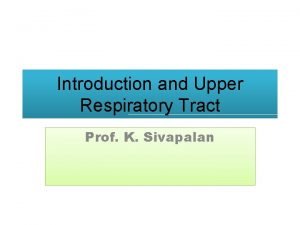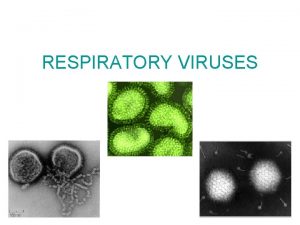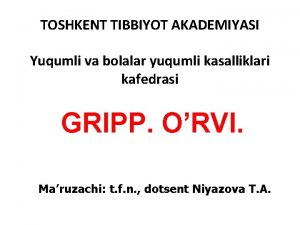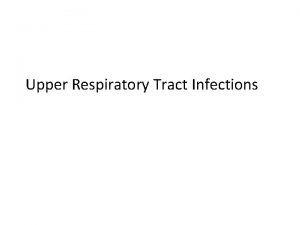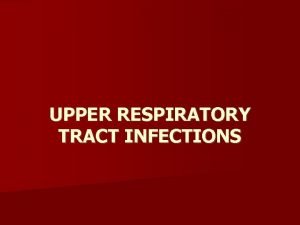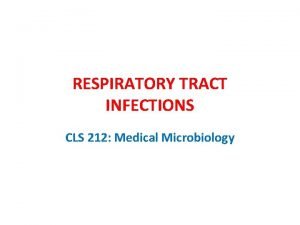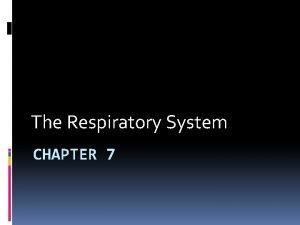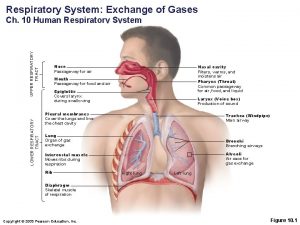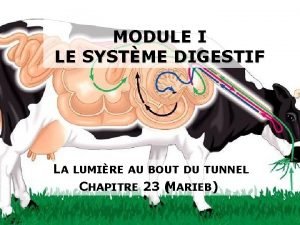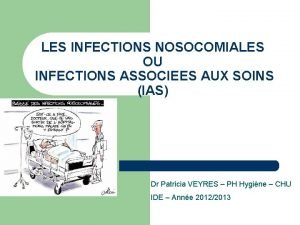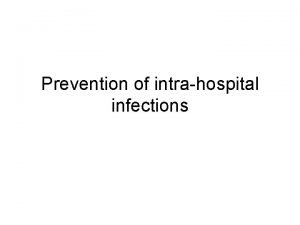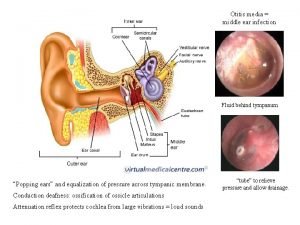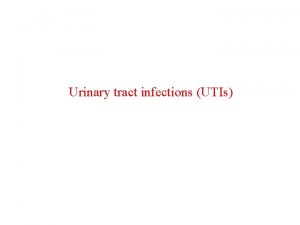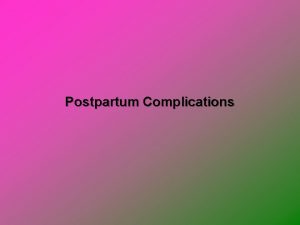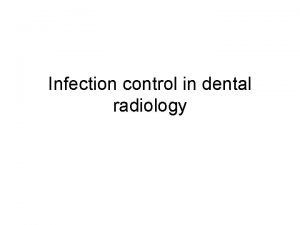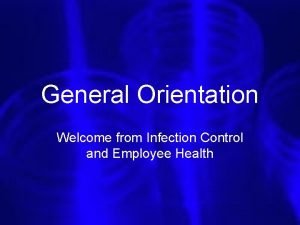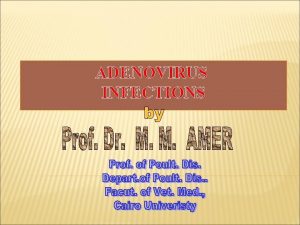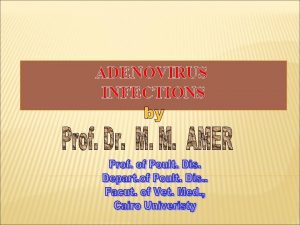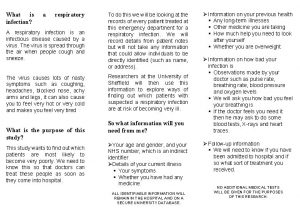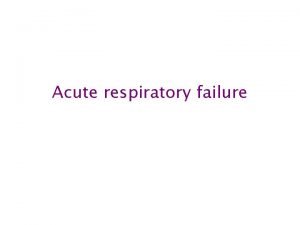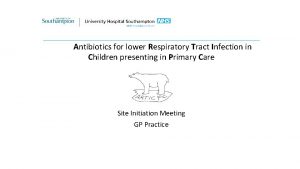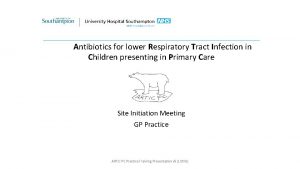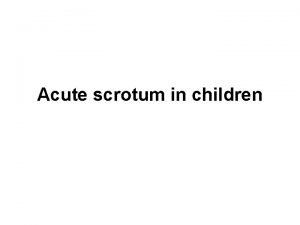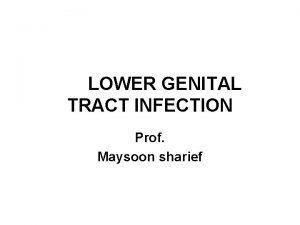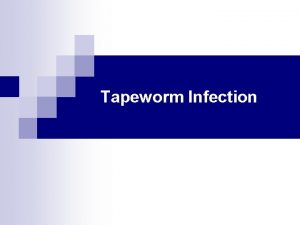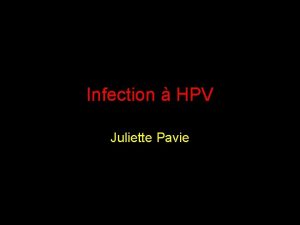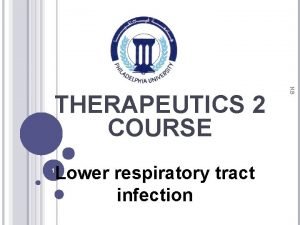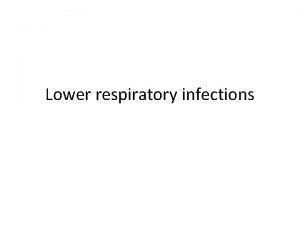Adenovirus Infection in Children with Acute Lower Respiratory
























- Slides: 24

Adenovirus Infection in Children with Acute Lower Respiratory Tract Infections in Beijing, China, 2007 to 2012 Chunyan Liu Beijing Children’s Hospital, Capital Medical University

Background • ALRTIs are the leading cause of pediatric morbidity and mortality worldwide • Human adenovirus (HAd. V) plays a significant role in pediatric respiratory tract infections, accounting for 25% of the overall respiratory illnesses and 4 -10% of the pneumonias BMC Infect Dis 2012, 12: 55 N Engl J Med 2015, 372(9): 835 -845 • ALRTIs caused by HAd. V can be severe, or even fatal, and are associated with the highest risk of long term respiratory sequelae

Background • Over 60 types of HAd. V have been identified and classified into seven species (A to G) • Cases of severe infection, outbreaks in closed populations, and even epidemic outbreaks have been associated with the newly emerging or reemergent types or variants J Clin Microbiol 2009, 47(3): 697 -703 Emerg Infect Dis 2011, 17(8): 1402 -1408

Background • Type identification is critical to epidemiological surveillance, detection of new strains, and understanding of HAd. V pathogenesis • To identify HAd. V types and species in children with ALRTIs in Beijing area and to characterize clinical features and laboratory findings of hospitalized HAd. V -infected cases

Methods • Patients and clinical specimens – From Mar 2007 to Dec 2012, pediatric patients with ALRTIs who presented in ED or were admitted to respiratory department or ICU, BCH – The patients were diagnosed with bronchitis, bronchiolitis or pneumonia – Nasopharyngeal aspirate or throat swab specimens were collected in VTM from each patient

Methods • Detection of respiratory viruses – Multiplex RT-PCR, single RT-PCR, or PCR: RSV, PIV, HRV/EV, IFV, HAd. V, HCo. V, HMPV, HBo. V Clin Microbiol Infect 2009, 15(12): 1146 -1153 Emerg Infect Dis 2011, 17(9): 1775 -1777 • Molecular typing and phylogenetic analysis of HAd. V: – HAd. V positive samples were further typed by PCR and sequencing Arch Virol 2006, 151(8): 1587 -1602 • Clinical data collection

Results • Frequency of HAd. V in children with ALRTIs – 3356 patients with ALRTIs (2766 with pneumonia, 309 with bronchitis and 281 with bronchiolitis) were enrolled in this study – At least one respiratory virus was detected in specimens of 2322 (69. 2%) enrolled participants – RSV (33. 4%) was the most commonly detected viral pathogen, followed by HRV (26. 6%) and PIV (13. 6%) – 194 patients(5. 8%, 194/3356) were found to have HAd. V infection

Results Fig Samples collected and proportion of samples with HAd. V identifid in each year, 2007 -2012

Results • Frequency of HAd. V in children with ALRTIs – The mean age of HAd. V infection was 2. 13 ± 2. 68 years (median, 1 year; age range, 1 month to 15 years) – One or more other respiratory viruses were detected in 69. 6% (135/194) HAd. V-infected participants – RSV (n= 56) was the most frequently co-detected virus, followed by HRV (n= 53) and PIV (n= 42).

Results • Typing of HAd. V – Four species (A, B, C, E) of HAd. V, including 11 different types were identified B – HAd. V-B 7(49. 0%) and HAd. V-B 3 ( 26. 3%), were the most prevalent HAd. V E A C

Results • Typing of HAd. V – Distinct hexon genes of different types (HAd. V-C 2 and HAd. VC 57) were verified in one specimen

Results Fig. Seasonal distribution of HAd. V infection in children with ALRTIs from 2007 to 2012

Results • Clinical features of HAd. V infections – Almost all hospitalized HAd. V-infected patients presented with fever (144/150, 96. 0%) and coughing (149/150, 99. 3%) and febrile seizures were noted in two febrile patients – 17 (11. 3%) required admission to the ICU and 38 (11. 3%) received mechanical ventilation – Clinical characteristics and laboratory findings showed no significant differences among patients with single HAd. V infection and those with HAd. V/RSV co-infections

Results

Results Table 2. Clinical information for HAd. V-B 7 and HAd. V-B 3 infected children Duration of fever (days) Immunoglobulin AST, median(IQR) (U/L) ALT, median(IQR) (U/L) LDH, median(IQR) (U/L) HBDH, median(IQR) (U/L) HAd. V-B 7 single infection (n=30) HAd. V-B 3 Single infection (n=15) p 22. 07± 21. 52 9. 73± 7. 31 0. 038 8 (26. 7%) 0 0. 038 67 (38. 8 -100) 33 (27 -45) <0. 001 20 (16 -36) 15(12 -21) 0. 029 565 (341. 8 -1232. 8) 297 (207 -397) 0. 001 408 (242. 8 -803) 219 (162 -313) 0. 001 AST, aspartate aminotransferase; ALT, alanine aminotransferase; LDH, lactate dehydrogenase; HBDH, hydroxybutyrate dehydrogenase;

Results • Clinical features of HAd. V infections – Two patients died in-hospital. Both of them required ICU admission and died of multiple organ failure – One was a 17 month-old boy with multiple underlying conditions of complex congenital heart disease and tracheobronchial malformation – The other was a previously healthy 18 month-old boy – Both fatal patients were infected with HAd. V-B 7 but no other respiratory viruses

Discussion • Some newly emerging or re-emergent types or variants were here identified – Five patients were found to have HAd. V-B 55 (formerly named HAd. V-11 a) – Caused an outbreak of ARI in a senior high school in Shanxi Province, China in 2006 J Clin Microbiol 2009, 47(3): 697 -703 – HAd. V-B 55 has been associated with several outbreaks of respiratory disease in other provinces in China Int J Infect Dis 2014, 28: 117 -122

Discussion • Some newly emerging or re-emergent types or variants were here identified – HAd. V-B 14 p 1 (formerly known as 14 a), was also found – HAd. V-B 14 p 1 has been associated with several large outbreaks of ARI in the United States and Europe Emerg Infect Dis 2011, 17(8): 1402 -1408 MMWR Morb Mortal Wkly Rep 2007, 56(45): 1181 -1184 – In 2011, an outbreak of febrile respiratory illness in Gansu Province, China was reported to be caused by HAd. V-B 14 p 1 Influenza Other Respir Viruses 2013, 7(6): 1048 -1054

Discussion • Some newly emerging or re-emergent types or variants were here identified – First report of detection of HAd. V-C 57 in respiratory samples collected from pediatric patients with ALRTIs and the first of co-detection of HAd. V-C 57 with HAd. VC-2 – HAd. V-C 57 (formerly designated strain 16700) was first isolated from the feces of a healthy child J Clin Microbiol 2011, 49(10): 3482 -3490 – Only three HAd. V-C 57 positive cases were found here and all were co-infected with other respiratory viruses, the pathogenic role of HAd. V-C 57 in respiratory infections will require further investigation

Discussion • Clinical features of HAd. V infections – No significant differences in clinical characteristics and laboratory findings were found between patients with single HAd. V infection and those co-infected with RSV – Reports from Peru and Chile showed the clinical severity to be the same in patients with single HAd. V infection and those with mixed RSV-HAd. V infections PLo. S One 2012, 7(10): e 46898 Pediatr Infect Dis J 2004, 23(4): 337 -341 – The clinical role of such co-infections will still require independent investigations

Discussion • Clinical features of HAd. V infections – Patients infected with HAd. V-B 7 tend to have higher casefatality rates than those with HAd. V-B 3 J Clin Microbiol 2003, 41(10): 4594 -4599 PLo. S One 2013, 8(1): e 53614 – Two fatal cases were recorded during the study period, and both of these patients were infected with HAd. V-B 7 alone – Patients with HAd. V-B 7 infection had longer duration of fever and higher serum levels of muscle enzymes than HAd. V-B 3 infected patients. – HAd. V-B 7 infection tended to cause more extrapulmonary tissue damage and may have more severe clinical consequence

Summary • A total of 11 different types of HAd. V were identified in children with ALRTIs and HAd. V-B 7 and HAd. V-B 3 were the most predominant types • Clinical entities of patients with single HAd. V infection were similar to those with mixed HAd. V/RSV infections • HAd. V-B 7 infection tends to have more severe clinical consequences • The presence of newly emerging types or variants and coinfection with different types of HAd. V highlights the need for constant and close surveillance of adenovirus infection

Contributors • Beijing Children’s Hospital, Capital Medical University Zhengde Xie Suyun Qian Kunling Shen Boping Xu Yang • Institute of Pathogen Biology (IPB), Chinese Academy of Medical Sciences Jin Zhang Jianguo Li Jianwei Wang Yan Xiao Li. Li Ren

Thank You for Your Attention
 Broncheols
Broncheols Life cycle of adenovirus
Life cycle of adenovirus Parranda grippi ppt
Parranda grippi ppt Lyphadenitis
Lyphadenitis Active phagocytes that increase rapidly acute infection
Active phagocytes that increase rapidly acute infection Lrti
Lrti Classification of upper respiratory tract infection
Classification of upper respiratory tract infection Respiratory zone of the respiratory system
Respiratory zone of the respiratory system Lower respiratory tract
Lower respiratory tract Lower respiratory system
Lower respiratory system The upper airways
The upper airways Upper and lower respiratory system
Upper and lower respiratory system Certification board of infection control and epidemiology
Certification board of infection control and epidemiology Schema colon
Schema colon Infection nosocomiale
Infection nosocomiale Chapter 19 disease transmission and infection prevention
Chapter 19 disease transmission and infection prevention Infection control committee
Infection control committee Scala media
Scala media Urinary tract infection in pregnancy ppt
Urinary tract infection in pregnancy ppt Postpartum infection
Postpartum infection Types of pathogens
Types of pathogens Darkroom infection control guidelines
Darkroom infection control guidelines Infection control orientation
Infection control orientation Kidney infection
Kidney infection Sexually transmitted diseases
Sexually transmitted diseases
